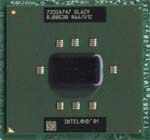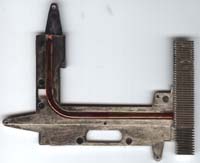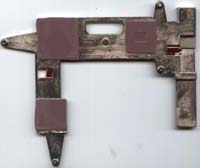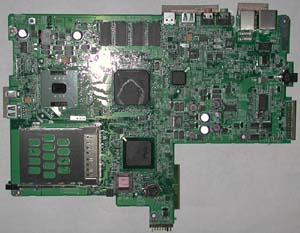Electrovaya Scribbler SC500 Tablet PC
by Matthew Witheiler on March 18, 2003 2:25 AM EST- Posted in
- Laptops
Construction: Under the Hood
The goal for the majority of tablet PCs we have seen to date is to provide a good mix between performance and battery life. Unlike a desktop replacement notebook or even a powerful thin and light, the tablet PC is not designed to take the place of your home PC but rather to accompany it. As a result tablet PC hardware can afford to be a bit slower than a desktop with the ultimate goal of producing a small system with long battery life. We felt that the Electrovaya Scribbler SC500 came outfitted very well to meet this goal. In brief, the unit comes with an ultra low volt Pentium III-M processor running at 866MHz, 256MB of PC133 memory, integrated Intel 830M video, and a 30.0 GB hard drive.
Electrovaya made what we feel is a wise decision when deciding to place an ultra low volt Pentium III-M chip at the heart of the Scribbler tablet PC. The ultra low volt Pentium III-M is a chip that Intel released over a year ago and took aim directly at the Transmeta Crusoe processor. In the world of ultra portable processors, power consumption is the name of the game. The less power the chip draws, the more usable it is. When Linus Torvalds came out an announced that a company that he helped fund, Transmeta, had produced a mobile processor that consumed a very meager amount of power and would be able to run x86 code, Intel must have had quite a scare. Nothing that Intel had prepared at the time was targeted at providing fast x86 performance at a low power consumption namely because Intel mobile chips were based almost entirely on the Intel desktop processor line. Clearly if Intel wanted a chip to compete head to head with the Transmeta Crusoe processor, a new type of processor would have to be thought up.
The result: the ultra low volt Pentium III-M. The ultra low volt Pentium III-M is based strongly off the Pentium III processor that enjoyed so much success on the desktop front; in fact the hardware behind the desktop part and the notebook part is the same. Like the most recent desktop Pentium III chips, the ultra low volt Pentium III-M features 512KB of on die L2 cache and can support either a 100MHz or 133MHz front side bus. What initially made the ultra low volt Pentium III-M chips different from their desktop counterparts was the process on which the chip was produced. The ultra low volt Pentium III-M chips came produced on a 0.13 micron process technology a short while before the 0.13 process made its way to the desktop line. This helped reduce the amount of power necessary to run the chip.
The 0.13 micron architecture was common to the entire Pentium III-M line. What makes the ultra low volt Pentium III-M special is the fact that the core operates on a miserly 0.975 volts on battery, compared to 1.10 volts for the low volt Pentium III-M chips and 1.35 volts for the standard Pentium III-M. The low voltage the ultra low volt Pentium III-M chips require help to cut power consumption fairly significantly. The power equation shows us why. The equation states that Power = Current * Voltage or P=iv. Thus, one of the two major portions determining power consumption of a chip is the voltage at which the circuit operates. By reducing the operational voltage of the ultra low volt Pentium III-M from 1.35 volts to 0.975 volts approximately 27% power was saved.
Reducing the voltage supplied to a processor also reduces the speed at which the processor can run (all you overclockers out there knew this already). As a result the ultra low volt Pentium III-M is currently only offered in speeds ranging from 800MHz to 933MHz. In contrast the standard Pentium III-M starts at 1.0GHz and goes all the way up to 1.33GHz.
Of course there is another competitor to the ultra low volt Pentium III-M now. In an attempt to revolutionize the mobile processor market, Intel last week introduced its Pentium M processor and Centrino technology. We took an in depth look at the new mobile technology in our review on the matter and even got a chance to look at some solutions utilizing the processor in our four system roundup. We have not had a chance to see any tablet PCs which utilize the Pentium M but we suspect many are on the way. Until one is in mass production, however, we are stuck to the ultra low volt Pentium III-M in tablets.
The CPU is mounted directly onto the motherboard surface and is not user upgradable.
Although the ultra low volt Pentium III-M is able to keep power consumption to a minimum like the Crusoe processor, it fundamentally differs from the Transmeta offering not only because it is designed on a native x86 architecture but also because it does not feature an on-die north bridge. One of the major selling points of the Transmeta Crusoe, besides its low power consumption levels, is that systems can be designed very small thanks to the fact that manufacturers do not have to use an external, discreet north bridge. Since the mobile Intel processors do not offer this functionality (which, as we mentioned, saves space and actually lowers power consumption), Electrovaya had to chose a north bridge solution to go along with the 866MHz processor.
Electrovaya wisely chose to mate the ultra low volt Pentium III-M with Intel's own 830M mobile chipset. There are third party chipset solutions to the Pentium III-M market but the Intel solution seems most appropriate in this instance. The 830M is the mobile version of the Intel i815 chipset and serves as a replacement for the aging 815EM mobile chipset. The main advantage that the 830M offers over the 815EM is 133MHz front side bus support (up from 100MHz) and PC133 memory support. These additions help make the 830M a more attractive mobile solution and add speed over the 815EM chipset it replaces.
Like the 815EM the 830M north bridge comes with integrated AGP 4x video, the same 815 graphics part used in the i815 desktop chipsets that featured integrated graphics. An integrated graphics solution makes perfect sense in the tablet PC market where 3D speed and the ability to drive a high resolution display are not necessary. In fact, the most important features of tablet PC graphics solutions are the ability to rotate the screen and use very little power: areas where the integrated 830M graphics succeeds. The use of an integrated graphics solution also saves precious board space as there need not be a home for an external graphics processor. In our opinion the only situation where use of a discreet graphics chip in a tablet PC is justified is when a discreet part is able to operate at a lower power than the integrated part or when no integrated part is available (such as in the Transmeta Crusoe tablet PC solutions).
The integrated video in the 830M chipset makes use of a shared memory architecture for video memory, meaning that a portion of system memory is set aside for video memory upon boot. This is a good solution when it comes to saving space but it does slow down the system somewhat by increasing the amount of information traveling over the already crowded system front side bus. Thankfully the 33MHz front side bus speed added to the 830M should help to alleviate this bottleneck to some degree.
You may be aware that Intel recently launched a new integrated graphics core found in the 845 series chipsets. This chip offers marginal improvements over the 815 graphics core namely by providing a single pipeline able to process four textures in a single pass. This graphics core is not yet available in mobile systems but we would not be too surprised to find the core make its way into the next generation of Intel mobile chipsets.
Another feature of the 830M chipset is its support for Intel SpeedStep technology. SpeedStep is only available in systems which use both -M mobile processors and an Intel mobile chipset. The feature allows the processor to dynamically clock itself between one of two speeds depending on need. In the case of our 866MHz ultra low volt Pentium III-M processor the chip runs at a full 866MHz while in use and underclocks itself to 400MHz (133MHz x 3.0 multiplier) while idle. A great power saving feature especially important in ultraportable systems such as tablet PCs.

Intel i830M north bridge.
The second component to the 830M chipset is the FW8280 south bridge. Mounted on the top of the motherboard, along with the CPU and north bridge, the south bridge. is fairly standard coming with USB controller offering support for up to 6 ports and an ATA100 IDE controller.

Intel FW8280 south bridge.
Everything in the Scribbler SC500 is passively cooled. From the CPU to the north bridge to the south bridge., all that keeps the chips cool is a small heatsink with a heatpipe running through it. The heatsink covers all three heat generating chips on the motherboard: the CPU, north bridge, and south bridge. The chips are arranged on the top of the SC500's motherboard in a L shaped arrangement and thus the heatsink is also L shaped. The top of the cooling system shows both an L portion with a copper heatpipe running through it as well as the small finned heatsink that lies along the far edge of the cooling solution. This portion of the heatsink, the location where heat exchange actually takes place, is located on the top of the tablet PC when oriented in portrait mode; the same place that we noted holes in the case of the Scribbler SC500. These holes aid in heat exchange, allowing cool outside air to make contact with the heatsink surface.
The bottom of the heatsink show that all three chips cooled by the unit are bonded to the metal surface thanks to the help of a thermal pad. The whole assembly is kept in place thanks to the help of four screws.
In the style of many mobile systems the Scribbler SC500 includes onboard RAM. In this instance the computer comes outfitted with 128MB of onboard PC133 memory mounted above the CPU along the right edge of the system while in portrait mode (the top edge in the motherboard picture below). Memory was also found mounted to the back side of the SC500's motherboard but we will get to that in a moment.
The top of the motherboard is also home to two additional logic chips. The first of these is an Analog Devices AD1886A JST audio chip. Your standard AC'97 codec.

The second logic chip is an ITE IT8761E-A Super I/O controller serving as the keyboard and mouse controller.
![]()
Below is a complete picture of the top side of the Electrovaya Scribbler SC500's motherboard. The chips described above should be fairly easy to see.















1 Comments
View All Comments
Poopship - Tuesday, December 18, 2012 - link
I asked for an ipad and this is what I got